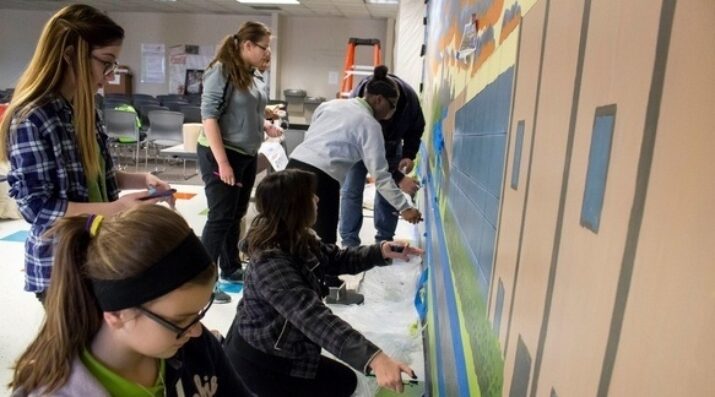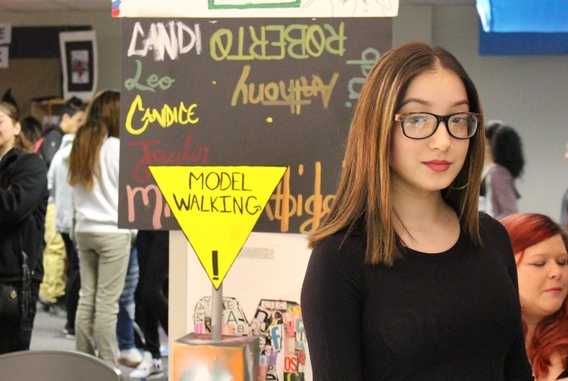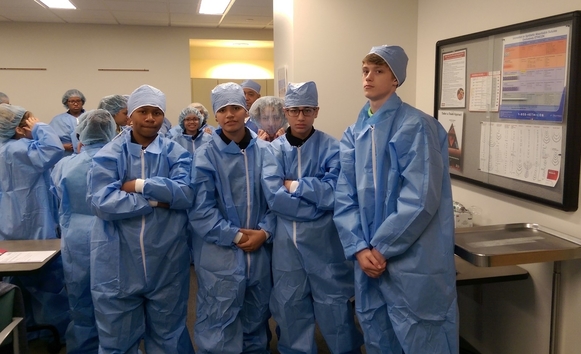New Designs for School
Successfully Ever After: Building 21’s Broader Competencies
Topics

We’ve all had the experience of truly purposeful, authentic learning and know how valuable it is. Educators are taking the best of what we know about learning, student support, effective instruction, and interpersonal skill-building to completely reimagine schools so that students experience that kind of purposeful learning all day, every day.
Practitioner's Guide to Next Gen Learning
Many schools and organizations in the NGLC network are considering the full scope of their students’ futures—lifelong learning, multiple careers, relationships, and civic engagement.
We believe that current graduation requirements represent “the wrong goalposts” and are a significant barrier to adequately preparing our young people for life and work after they leave school.
—Building 21 Model Expansion Plan
“And they lived happily ever after.” Think about how many of the old fairy tales ended with that line. As a child I did not question the assumptions undergirding that statement: that all of the adventures worth telling about had already happened. The monster was slain, the spell was broken, the young couple were married. End of story, literally. As adults we realize that, even though the story is ending, our young hero and heroine are just getting started. A whole lifetime of adventures awaits after we close the book on them.
As an educator, I’ve always known that passing my course, graduating from our school, or getting into college was not the end of the story for my students. Even so, I’ve sometimes acted as if it was. With the pressures of time (never enough!) and accountability (never good enough!), it’s easy to get caught up in narrow, short-term thinking about what student success looks like.
Still, many schools and organizations in the NGLC network are actively resisting such limited thinking. They are considering the full scope of their students’ futures—lifelong learning, multiple careers, relationships, and civic engagement—in their definitions of student success. Correspondingly, they are adopting more expansive sets of competencies so that their graduates can succeed and thrive in a world of accelerating change.
For example, the competency-based public high schools that comprise the Building 21 (B21) network in Philadelphia and Allentown, PA, are doing just that. For this edition of Friday Focus: Practitioner’s Guide to Next Gen Learning, I spoke to Chief Instructional Technologist, Tom Gaffey, and to Sandra Moumoutjis, B21’s Chief Instructional Designer, about how B21 used NGLC’s MyWays Student Success Framework to build on their competency-based model. Starting with next year’s incoming freshmen, B21 graduation requirements will elevate—and assess—all of the competencies students need for the future, not just the traditional academic ones. In particular, I asked them,
- What role did MyWays play in your work to redefine success at B21?
- How did B21 integrate broader competencies into its model?
- How will students benefit from these changes?
New Goalposts for a Changing World
My big “a-ha” moment was the first MyWays report, which introduced the idea of a wayfinding decade—the different work/learn pathways students go through—and how they are not prepared for it.
—Tom Gaffey
We are living in an extraordinary time. To succeed and thrive, young people need much more than the narrowly defined content knowledge we currently offer and test for. In addition to deep, meaningful content knowledge, our students need to develop interpersonal and intra-personal skills, habits, and behaviors that are essential to learning, success, and well-being. They need what MyWays refers to as Creative Know How and B21 calls Nextgen Essentials—to think critically, present their ideas, and communicate effectively. They need to know how to find their way through a lifetime of decisions around work and learning. Educators cannot alter the realities our graduates are facing, but we can change how well we prepare students to face them.
The MyWays Student Success Framework, informed by over 25 other frameworks in the areas of education, human development, and work, takes into account this fuller range of student learning. It’s not a set of curriculum standards as we know them. It’s not a checklist of component parts intended individually to drive curriculum, pedagogy, scheduling, and assessment. Instead, MyWays is designed to support learners, schools, and school districts or networks to look more thoughtfully at and update their existing goal-line or create a new one. This is precisely how B21 used the Framework.

Building 21’s Learning What Matters Competency Framework, adapted from the MyWays Student Success Framework
Building 21 was founded on a belief in individuals’ unlimited capacity for creativity, innovation, and self-realization when they are free to pursue their passions and interests. The network’s competency-based learning model has been in place since they opened in 2014, and it includes many elements of next gen learning, such as real-world learning experiences with industry partners, problem-based learning, and competency-based assessment.
As Sandra describes, “We had all of our content competencies in place. We had a system where students would fill up a portfolio that was competency based and earn credit.” However, B21 offered quite a lot of valuable learning experiences and opportunities for skill development that were not neatly captured in the portfolios or explicitly credited toward graduation: electives, capstones and “celebration of learning” exhibitions, habits of success, and workplace experiences, for example. “We were pretty solid on academic competencies, but we were struggling with these other competency sets and these other kinds of experiences,” she recalls.

B21’s fashion design students held their annual fashion show in February as part of a COL (celebration of learning performance task) for an authentic audience.
Tom explains how MyWays served as a catalyst for elevating a broader range of competencies: “We were looking for a solution to represent these electives and other experiences in a coherent way. The MyWays report was released at this time, and it was a really good excuse to dive into it and talk to industry partners, to reframe what we were trying to do and how to best represent it in our model. That’s where the idea of the wrong goal post came in,” he says. “We realized we were actually measuring the wrong things. We were not measuring things students absolutely need, and we wanted to fix that.”
No “Other” Learning
When we dug into MyWays, it changed our lens around the “why” of electives and other experiences. Why are we doing this? What if we created these competency sets and everything was connected to a portfolio of work and generated credit? Then everything operates the same as the academic competencies and there is no “other.”
—Sandra Moumoutjis
According to Tom, the MyWays Student Success Framework initially served as a test of B21’s existing competency sets. “MyWays offers one of the smartest perspectives on the profile of a graduate and was a test for where our holes were,” he explains. “We cross-walked the MyWays Framework with what we were doing with our program. We are still thinking about some holes, but it served as a validation of what we are doing.”
“It unlocked the problem we were trying to solve,” says Sandra. “We literally sat down and rearranged our competencies into the four [MyWays domains]. This provided coherence and served as a catalyst to create new credits and new portfolios to make our model 100 percent competency based.”
Tom is quick to point out that at B21, “courses” do not look the same as they do in traditional models. They are a “series of experiences and competencies that get assessed and give you credit, experiences that you may be doing with teachers or with partners or more independently, which then get added to your portfolio for credit,” he says.
“That’s how we’ve been thinking about our academic competencies for four years. But then we started rethinking how we looked at electives,” Tom recalls. “Are they just ‘things that happen’ or are they portfolios?” In aligning all coursework and experiences to the four competency domains, or “buckets,” and assessing them via portfolios, “Everything has now become the same thing. We can equally value learning experiences that are not strictly academic or even happening in the school day,” he explains.
An added benefit, according to Sandra, is that the portfolios hold students equally accountable for all courses, experiences, and competencies. “It’s unfortunate,” she says, “but one lesson we learned was that if it wasn’t part of a portfolio, teachers didn’t value it as much and students didn’t value it as much. At the same time, the feedback we were getting from partners was that these are the skills that are lacking and they are very important. We wanted to elevate their importance—what is assessed is taken seriously.”

B21 Allentown students experience the sterile processing department at the Lehigh Valley Health Network as part of their healthcare career pathway.
Looking Ahead to a New Cohort
Next year’s freshmen will be the first cohort of students to fully experience this MyWays-inspired iteration of B21’s model. Tom’s hopes for these students include “having the skills—and not just the academic skills—to navigate options, choices, and experiences with the lens of trying to find their passion and what they want to do with their lives. I want students to have agency and be adequately prepared so they all leave with a passion to pursue in their postsecondary lives.”
For Sandra the power of these broader competencies also lies in the potential effect on students’ communities. “A big piece of our problem- and project-based model is impact, with students knowing how to make an impact on their community and world. These competency sets will really help students do this,” she asserts. “They will walk away knowing that the learning they’ve done has empowered them to have a greater impact on the world.”
And that would be a happy ending indeed.
Resources
- The Building 21 Model Expansion Plan describes the implementation of B21’s new definitions of success in greater detail, including how credit is assigned, and the tools and systems the network uses to implement their model.
- This link to B21's Google Drive includes all of the competencies for the entire framework.
- This Learning What Matters Habits of Success document provides examples of non-academic competencies and continua, which are rubrics of skills that support progression-based grading.
- The MyWays Student Success Series addresses the key questions involved in developing broader, deeper competencies: why the urgency to change, what does success look like, and how to approach learning experience design and assessment of learner progress.
- To see the “why” analysis that sparked Tom Gaffey’s “a-ha” moment, see Opportunity, Work, and the Wayfinding Decade.
- For an introduction to the competency framework itself, see Welcome to the MyWays Student Success Framework, which is supported by reports on each of the four framework domains.




